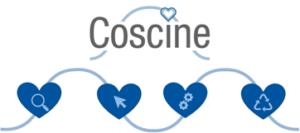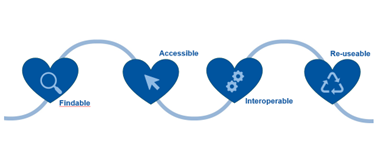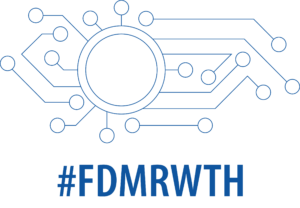Wer sich bisher noch nicht in Coscine verliebt hat, wurde spätestens am 14. Februar 2023 – passend zum Tag der Liebe – in den Bann der Forschungsdatenmanagement-Plattform gezogen. Wieso Coscine für Herzrasen sorgt, haben wir für Sie in diesem Nachbericht zur Veranstaltung Coscine – FAIRly in Love with Research Data, die im Rahmen der Love Data Week stattfand, zusammengefasst.
Ein Kennenlernen wie im Speed Dating
Alle diejenigen, die noch nicht wissen, was Coscine ist und wer dahintersteckt, aufgepasst:
Coscine ist eine Open Source Plattform, die es Forschenden ermöglicht, ihr Forschungsdatenmanagement (FDM) auf höchstem Niveau und nach der guten wissenschaftlichen Praxis zu betreiben. Die Plattform wurde am IT Center der RWTH Aachen University entwickelt und wird derzeit hochschulübergreifend angeboten.
Aber wieso sollte man sich in eine FDM-Plattform verlieben?
Ganz einfach! Dank der Projektstruktur ermöglicht Coscine eine einfache Datenverwaltung sowie Zugang für alle Projektmitglieder, welche Zugriff auf ihre Projektdaten und ihren Code haben. Außerdem können Forschungsdaten automatisch mit Metadaten verknüpft sowie individuelle und projektspezifische Anwendungsprofile, sogenannte Applikationsprofile, erstellt werden. Diese Applikationsprofile beinhalten wiederum individuelle Metadatenkombinationen aus verschiedenen Metadatenschemata und Termen. Als Ressourcen für die Datenquellen werden integrierte IT-Dienste wie der Forschungsdatenspeicher (Research Data Storage, RDS) und GitLab angeboten. Zukünftig wird außerdem die Einbindung von Nextcloud sowie Sciebo angestrebt. Bei Verwendung des RDS als Speicherressource können die Forschungsdaten nach Projektende für 10 Jahre archiviert werden. Nicht zuletzt werden durch Coscine alle FAIR-Prinzipien unterstützt.
Konnten wir Sie überzeugen?
FAIRly in Love
Coscine schafft es, mit den FAIR-Prinzipien in einem ganz besonderen Einklang zu sein. Was macht Coscine also FAIR?
Mithilfe des Logins über SSO und ORCID werden institutionelle Grenzen für den Zugang zum jeweiligen Projekt aufgehoben. Die einzelnen Accounts ermöglichen eine Authentifizierung der Eigentümer*innen bzw. aller Mitwirkenden am Datensatz sowie benutzerspezifische Rechte wie Owner, Member oder Guest. Somit werden Forschungsdaten zugänglich und wiederverwendbar gemacht.
Metadaten werden auf Projekt-, Ressourcen- und Dateiebene erfasst und dabei automatisch mit den Forschungsdaten verknüpft. Optional können die Metadaten innerhalb von Coscine öffentlich zugänglich gemacht werden. Außerdem sind sie über ElasticSearch durchsuchbar. Die technische Abbildung und Validierung geschieht über die W3C-Standards RDF und SHACL. Zusätzlich ist eine Anbindung an den NFDI4Ing Metadaten-Hub über „FAIR Digital Object“ Schnittstellen geplant. All diese Aspekte tragen dazu bei, dass die Forschungsdaten auffindbar, interoperabel und wiederverwendbar sind.
Der Applikationsprofilgenerator vom Projekt AIMS (Applying Interoperable Metadata Standards) ermöglicht die Erstellung von Profilen mit individuellen und disziplinspezifischen Metadaten, wodurch keine technischen Kenntnisse im Bereich von RDF und SHACL erforderlich sind. Dies macht Forschungsdaten auffindbar und interoperabel.
Durch verschiedenen Ressourcentypen wird die Speicherung von Forschungsdaten möglich gemacht. Unter anderem besteht Zugriff auf den RDS via Webbrowser oder S3-Client. Dort wird ein Aufbewahrungs- und Archivierungszeitraum von zehn Jahren ab Projektende garantiert. Mithilfe von Linked Data können extern gespeicherte Forschungsdaten und dank GitLab-Ressourcen projekt-bezogene Repositorien verknüpft werden. Daraus resultiert, dass die Forschungsdaten möglichst wiederverwendbar sind.
Mittels Handle-basierter ePIC Persistent Identifier (PID) werden die Speicherorte der Forschungsdaten eindeutig und dauerhaft identifizierbar sowie auf globaler Ebene referenzierbar. Des Weiteren werden Fragment-Identifikatoren für einzelne Dateien durch erweiterte Handle-URLs ermöglicht. Dies macht die Forschungsdaten auffindbar und zugänglich.
Bei RDS-Ressourcen ist, abhängig vom Ressourcentyp, eine Interaktion über Browser, S3-Protokoll oder REST-API möglich. Durch die REST-Schnittstelle sind Daten und Metadaten unabhängig voneinander auffindbar und zugänglich. Durch die einfache Eingabe von Daten und Metadaten in das System wird die spätere Nutzung erleichtert. Außerdem ermöglicht die Schnittstelle Arbeitsabläufe zu automatisieren. Somit werden die Forschungsdaten auffindbar und zugänglich gemacht.
Warum Ihre Forschungsdaten weiterhin Ihre Zuneigung benötigen
Eine Langzeitarchivierung liegt außerhalb des Rahmens von Coscine. Forschende müssen daher für eine Verfügbarkeit über zehn Jahre nach Projektende hinaus ihre Daten und Metadaten an ein entsprechendes Archiv bzw. Repositorium übergeben.
Zudem liegt die Reichhaltigkeit der Beschreibung in den Forschungsmetadaten (z.B. die Wahl des Applikationsprofils, Workflows) sowie die Angabe einer Lizenz in der Hand der Forschenden.
Da Coscine eine hohe Flexibilität in der Erstellung von Applikationsprofilen ermöglicht, müssen Forschende ihrerseits sicherstellen, dass sie bei der Erstellung individueller Applikationsprofile auf geeignete fachspezifische kontrollierte Vokabulare und Ontologien verweisen und somit (Meta-)Daten entsprechen domänenrelevanten Gemeinschaftsstandards verwenden.
Zukünftige FAIR-Besserungen
Das Protokoll ist offen, kostenfrei und universell implementierbar.
Für Metadaten wird an der Implementierung eines FAIR Data Point als standardisierte Schnittstelle gearbeitet.
Metadaten sollten zugänglich sein, auch wenn die Daten nicht mehr verfügbar sind. Daher wird zukünftig ein dauerhafter Platzhalter mit Metadaten von gelöschten Ressourcen implementiert.
Damit (Meta)Daten qualifizierte Verweise auf andere (Meta)Daten enthalten, können diese bislang nur manuell hinzugefügt werden. Daher wurde ein Projekt beantragt, um eine vordefinierte Option zur Verknüpfung von (Meta-)Datensätzen hinzuzufügen.
Zusätzlich wird eine technische Versionierung von (Meta-)Daten derzeit implementiert.
Workshops leben vom Austausch miteinander
Die rege Teilnahme am Workshop mit rund 40 Teilnehmenden aus ganz Deutschland ermöglichte eine interessante Diskussion und viele Einblicke in die Funktionen von Coscine. Interessierte wurden im Workshop live durch die Plattform geführt und konnten abschließend ihre Fragen stellen. Die spannendsten Fragen inklusive der Antworten haben wir für Sie noch einmal aufgeführt.
1. Frage:
Wird Coscine über alle Fakultäten/Bereiche der RWTH Aachen University genutzt? Gibt es Fachgebiete, die Coscine nicht verwenden können?
Antwort:
Ja, Coscine wird bereits unabhängig vom Fachbereich an der RWTH Aachen University genutzt und ist eine generische FDM-Plattform (d.h. ohne fachwissenschaftlichen Schwerpunkt). Da die RWTH einen großen Schwerpunkt im Bereich der Ingenieurwissenschaften hat, sind bislang hauptsächlich zugehörige Fakultäten in Coscine vertreten. Coscine erfragt zunächst nur generische Metadaten-Felder auf Projekt- und Ressourcenebene, die fachspezifische Applikationsprofile auf Dateiebene können von Forschenden selbst ausgewählt bzgl. erstellt werden. So kann jedes Fachgebiet Coscine für sich individualisieren.
2. Frage:
Beziehen Sie die ePIC-PIDs von der GWDG oder haben Sie eine eigene Infrastruktur an der RWTH?
Antwort:
Die ePIC-PIDs werden von der GWDG bezogen. Das GWDG stellt uns dafür zwei Server bereit, einmal für Test PIDs und einmal für die produktiven PIDs.
3. Frage:
Wenn Coscine nicht für Langzeitarchivierung gedacht ist, sind die PIDs dann auch nicht wirklich persistent, oder?
Antwort:
Die PIDs, die von Coscine ausgegeben werden, verweisen persistent auf das dahinter liegende digitale Objekt, welches immer eine Ressource in Coscine ist. Die Daten, die wiederum in der Ressource gespeichert werden, können sich jedoch ändern. Nur so können PIDs für „warme“ Daten ausgegeben werden – indem sie sich lediglich auf die Speicherumgebung der Daten beziehen (für RDS betrifft dies das jeweilige S3-Bucket). Sobald die 10 Jahre der Archivierung nach Projektende verstrichen sind, werden die Daten gelöscht. Die PID wird weiterhin auf den Ort (z.B. das gelöschte S3-Bucket) zeigen. Daher wird zukünftig an diesem Ort ein dauerhafter Platzhalter mit Metadaten für gelöschten Ressourcen implementiert.
4. Frage:
Inwieweit ist die Nutzung von Coscine (schon) verbindlich oder wird sie bisher nur empfohlen?
Antwort:
Die Nutzung von Coscine ist nicht verbindlich und wird zukünftig auch weiterhin auf freiwilliger Basis angeboten und empfohlen. Attraktiv wird die Nutzung für Forschende vor allem durch den Zugang zu kostenlosem Speicherplatz auf dem RDS und der Einhaltung von FDM-Richtlinien gemäß von Antragsvorgaben.
5. Frage:
Wie lange lief Ihre Pilotphase?
Antwort:
Die Pilotphase von Coscine startete im März 2020. Wir streben an, Coscine im zweiten Quartal 2023 in den Regelbetrieb zu überführen.
6. Frage:
Wie groß ist das Team der Entwickler*innen, die an Coscine arbeiten?
Antwort:
An Coscine arbeiten ca. zehn Mitarbeitende mit unterschiedlichen Schwerpunkten sowie Arbeitsverhältnissen – in Summe mit etwa sechs Vollzeitstellen. Die Entwickler*innen sind dabei über verschiedene Drittmittel-Projekte angestellt.
7. Frage:
Wo landen neue Applikationsprofile, die mit dem Applikationsprofil-Generator von AIMS erstellt werden?
Antwort:
Neue Applikationsprofile werden im zugehörigen und offenen Coscine-GitLab Repositorium hinterlegt.
Abschluss
Wir bedanken uns bei allen Teilnehmenden für das Interesse an Coscine und den daraus entstandenen erfolgreichen Austausch miteinander. Bis zum nächsten Mal!
Mehr erfahren
Sie möchten keine News über Coscine mehr verpassen? Dann abonnieren Sie unsere Mailingliste und besuchen Sie uns auf unserer Webseite.
Sie haben Fragen oder Feedback? Dann schreiben Sie eine Nachricht an das IT-ServiceDesk. Wir freuen uns auf Ihre Nachricht!
______
Verantwortlich für die Inhalte dieses Beitrags sind Ilona Lang und Arlinda Ujkani.








Schreibe einen Kommentar
Du musst angemeldet sein, um einen Kommentar abzugeben.